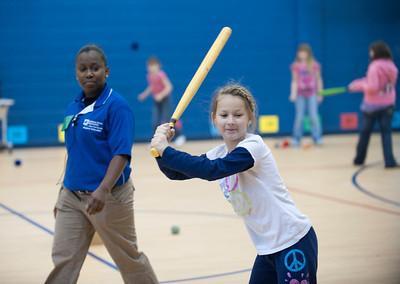
ISU physical education students give statistics to their teaching performance through the use of performance analyzing software.

ISU physical education students give statistics to their teaching performance through the use of performance analyzing software.
With three solid years of baseball experience under her belt, 8-year-old Macy Ramey has little difficulty using her foam bat to whack a yarn ball high against the gymnasium wall of Terre Town Elementary School in Terre Haute.
During a day at play, she stood back as a classmate pitched the ball to her and took a level swing that sent the ball soaring.
"That's it. Swing like you're clearing the table," Indiana State University senior physical education major Erynn Williams told her and nearly 20 of Ramey's third grade peers. "Extend your arms and clear the table."
Williams is one of two ISU students who during the spring semester made a weekly trip to the elementary school to help young students develop their physical abilities. In many ways, Williams' and junior physical education major Cathy Fitzek's work was like that of traditional student teachers. They developed lessons plans geared toward the grade level of the students they were teaching, and refined their abilities to deliver instruction throughout the semester.
It was the video camera in the corner that made their work a bit unique.
Susan Hagood, assistant professor of physical education, has for several semesters incorporated the use of video cameras in her instruction in order to help students see what they might otherwise miss.
"You're so stressed out when you're actually in the lesson that sometimes you forget little things that happened or exactly what you did in response to something," Hagood said."Video is that accountability piece that doesn't lie."
After Hagood's students leave the elementary school and return to campus, they study together the video images they've collected in order to improve their skills.
They identify on film the moments when the third-grader lost control of the ball he was supposed to be bouncing and began trying to shoot it through the basketball goal. They spot the girl who pouted and sat on the floor when a classmate wouldn't give up her turn at bat.
Careful examination of the video also helps Williams, formerly an ISU cheerleader, hear how timid her voice sounds when she's explaining the rules of her exercise.
"I hate that," she said, while critically analyzing her videotape. "I have to talk louder."
"Yes, you do," Hagood said.
After collecting and analyzing videotape recordings of student performances, and recommending solutions for improvement, most professors might be inclined to end the instruction there. But Hagood takes an additional step by having students review their recorded performances more objectively - using Best Analysis software.
The software enables the students to "code" their performances to document the amount of time they spend demonstrating, evaluating, correcting, signaling, and answering questions for the youngsters they're teaching.
Students can then see a statistical breakdown of their work on charts and graphs prepared with the Best Analysis software.
"After we look at the coding, we print out a comparison that gives them numbers to go along with what they're doing." Hagood said. "They see what percentage of their time they've spent with each activity. We're able to discuss what the appropriate amount of feedback might be and have those deeper conversations about what is effective teaching and how that works."
For Hagood, teaching students the art of teaching is a multi-faceted process with each activity building on the last, maximizing what students can learn in the course of a semester.
"They teach eight lessons in the whole process so they can look at where they start and how they have progressed," Hagood said. "They can create individual goals, accomplish one goal and then set a new goal."
Ultimately, it's a process that provides Hagood with sound statistical data with which to evaluate students while supplying her department with necessary documentation required for accreditation.
"It's a win for the schools, a win for the students, a win for us," she said. "Everyone benefits."
Terre Town Elementary physical education teacher Ann Roberts agrees.
"Oh this is great, this is awesome," she said of her work with the ISU students. "My students love having someone else come out and work with them like that. They kind of get tired of seeing me all the time."
The youngsters also appreciate the opportunity to learn something new.
Even though Ramey considered herself an experienced baseball player before her student teacher's lesson began, she realized by the end of her hour with the foam bat that Williams had given her a new strategy for perfecting her game.
"The ISU teachers help us and they tell us a lot," Ramey said. "A couple of times, I was swinging too high. Clearing off the table is a good thing to remember."
Contact: Susan Hagood, assistant professor of physical education, College of Nursing, Health, and Human Services, Indiana State University, susan.hagood@indstate.edu or 812-237-4168.
Writer: Rachel Wedding McClelland, assistant director of media relations, Communications and Marketing, Indiana State University, rachel.mcclelland@indstate.edu or 812-237-3790.
ISU student Erynn Williams stands by as 8-year-old Terre Town third-grader Macy Ramey practices her swing (ISU Photo/Kara Berchem).
Terre Town Elementary School kindergarteners learn the fine points of dribbling during an exercise with ISU student teachers (ISU Photo/Kara Berchem).
ISU Assistant Professor Susan Hagood works with ISU student teachers at Terre Town Elementary School to help them perfect their teaching skills (ISU Photo/Kara Berchem).